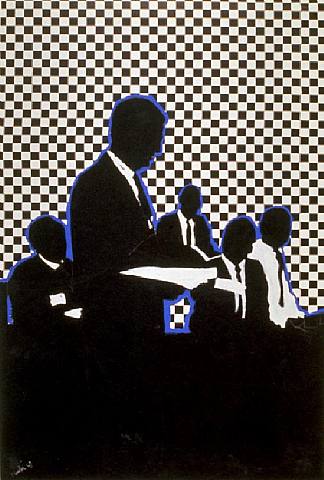I was lucky enough to meet artist Idelle Weber at an event at Tufts University’s gallery for the traveling show, Seductive Subversion: Women Pop Artists, 1958-1968. I won’t be the first or the last to note that Weber’s suited silhouette men (and women) look remarkably contemporary and have been appropriated consciously or not by all kinds of artists and designers. Pop art was all about appropriating advertising images, so it’s not so far out that everybody’s favorite show about advertising appropriated right back. What’s far out is that I’ve been involved in design projects that do the very same, thinking that we were borrowing some cool cachet from Mad Men.
 |

|
Does she have a case? I’m not a lawyer and I don’t have a TV, so I’ll just speculate. Copyright protection is about a particular expression, and patents don’t really cover this sort of thing, so I’d say no, not really. Jeff Koons recently found out that his particular expression of a balloon dog does not grant him a universal monopoly on balloon dogs. Does she have cause to gripe? Well, that’s another story. I generally prefer to take the “flattery” line on such things, especially when the marketability of the original work is not diminished – maybe it’s even enhanced – by the fawning if uncredited homage.
In a panel discussion around Seductive Subversion, Weber was questioned directly about the silhouette theme and indirectly about Mad Men. She recounted an early memory of having a silhouette made at a fourth of July fair, and also how her first impressions of New York City (she moved from the West coast to pursue a career in art) included the swarms of identically-suited anonymous businessmen, visible in the streets, on escalators and through the windows of glass box office buildings.
I think her piece(s), Nine Cubes is even more engaging than the much larger canvases and collages of business-suited men in silhouette. It’s nine lucite cubes (source on Canal Street!) with hand-painted and silk-screened office scenes featuring the silhouette office men. The transparency of the lucite, the square format and the stacked arrangement all recall the view into offices through windows. Scroll down here for a good pic that shows the one cube face featuring a female office worker. I wonder what her story is.
Weber on Mad Men’s use of a silhouette man in the logo, “I wish they would just do them a little bit better,” and on the general interest in the period, “Why is that era so taken up? It was just so dull.” And finally, philosophically, on the general traffic and reuse of artistic themes, images and ideas, “that’s hard to pin down, who takes what.” Indeed.


Thanks! A note will follow.
IW